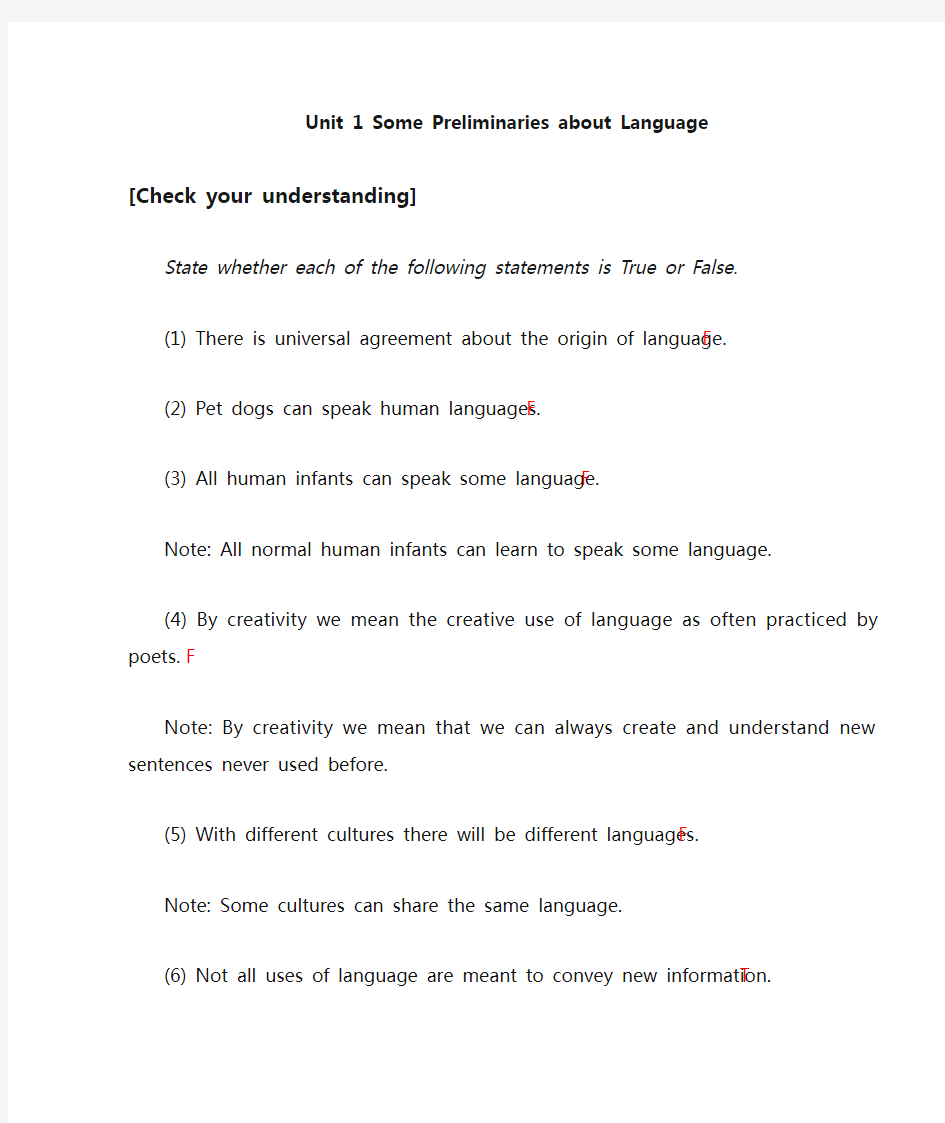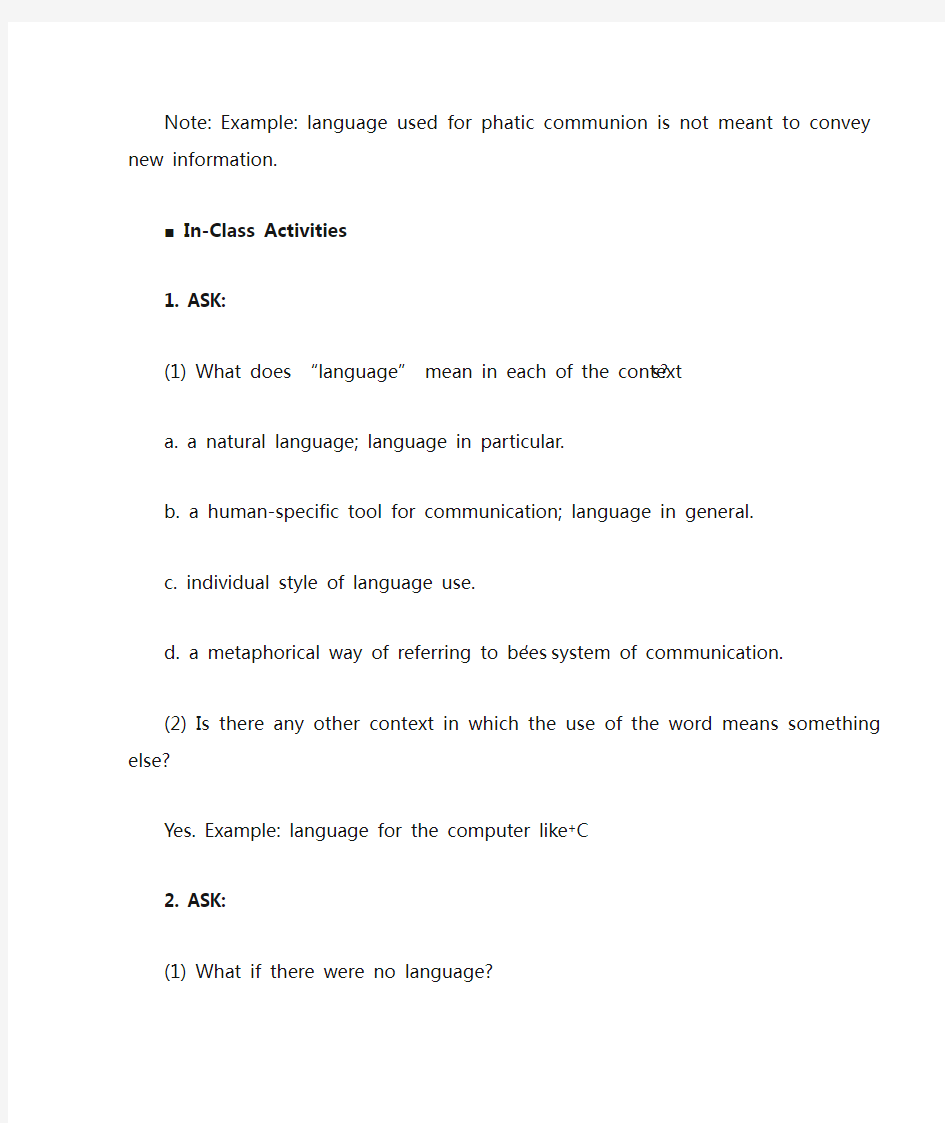

Unit 1 Some Preliminaries about Language
[Check your understanding]
State whether each of the following statements is True or False.
(1) There is universal agreement about the origin of language. F
(2) Pet dogs can speak human languages. F
(3) All human infants can speak some language. F
Note: All normal human infants can learn to speak some language.
(4) By creativity we mean the creative use of language as often practiced by poets. F
Note: By creativity we mean that we can always create and understand new sentences never used before.
(5) With different cultures there will be different languages. F
Note: Some cultures can share the same language.
(6) Not all uses of language are meant to convey new information. T
Note: Example: language used for phatic communion is not meant to convey new information.
■ In-Class Activities
1. ASK:
(1) What does “language” mean in each of the context s?
a. a natural language; language in particular.
b. a human-specific tool for communication; language in general.
c. individual style of language use.
d. a metaphorical way of referring to bees’ system of communication.
(2) Is there any other context in which the use of the word means something else?
Yes. Example: language for the computer like C+
2. ASK:
(1) What if there were no language?
Omit.
(2) What if there were only one language the world over?
Omit.
(3) What can we learn from this Bible story?
Language is powerful as a tool of human communication.
3. ASK:
(1) Do you think the two statements are equally probable, and if not, why not?
(a) is more likely than (b), because the word as the basic unit of meaning that can occur independently in language is finite in number, whereas the sentence as composed of words, though almost infinite in number, is made possible by our knowledge of vocabulary and grammar. We can always produce and understand sentences that we never come across before. In that sense, no sentence is really new.
(2) In what context do we make the second statement?
When we focus our attention on the meaning of a sentence or when we are concerned with the
form of a sentence as found in a language class.
4. ASK:
(1) Are there onomatopoeic words in Chinese?
Yes. e.g. “哗啦”、“扑通”、“喀嚓”.
(2) Does the existence of onomatopoeic words overthrow the claim that language is arbitrary?
No. Onomatopoeic words account for a very limited percentage in the vocabulary of a language.
5. ASK:
(1) Can one really invent a language of one’s own?
No.
(2) If not, why?
A language comes into being and use by convention or agreement among its speakers.
6. ASK:
(1) Is there any basic flaw in this experiment?
The process is not strictly controlled. There may have been some coincidence. The sample size is too small for the experiment to be valid.
(2) Do you think we really can answer the question about the beginning of language?
No, at least in the present condition where/when we cannot perform experiments on the human brain, the key organ of speech.
7. ASK:
(1) Can you identify the most likely order (from least to most advanced) of these samples?
C→B→A
(2) What features in each child’s utterances can you use as evidence to support your ordering?
Child A: good syntax except for improper question form.
Child B: visible development of syntax; overgeneralization
Child C: Not much syntax; two-word utterances; telegraphic sentences (sentences that contain only content words but lack function words)
8. ASK:
(1) It is often assumed that children imitate adults in the course of language acquisition. Can
imitation account for the above production on the part of the child?
Not wholly. There is counter evidence against the assumption, like the overgeneralization “go-ed” for “went”.
(2) What distinguishes the child’s production from that of the adult?
Overgeneralization of “-ed” for the past tense as shown by “holded”.
9. ASK:
(1) How do adults reinforce the process of children’s acquisition as exemplified here?
They use explicit correction.
(2) Do children know what they are doing wrongly?
Not exactly.
(3) Do the adults succeed in their reinforcement?
Not always, at least.
(4) How should we treat the “mistakes” that children make while acquiring their mother tongue?
We may ignore them sometimes, although some amount of reinforcement may turn out to be helpful.
10. ASK:
(1) Do children learn through structured or simplified input, as suggested?
Not always. There is evidence for both sides.
(2) Can you offer some examples illustrating, representing the way adults talk to infants?
Omit.
Note: Motherese is characterized by shorter sentences, higher pitch, exaggerated intonation, higher proportion of content words to function words, simple syntax, more interrogatives and imperatives, more repetitions. Yet it is not syntactically simpler. Rather, it may include syntactically complex sentences such as questions: Do you want your juice now?Embedded sentences: Mommy thinks you should sleep now. Imperatives: Pat the dog gently! Negatives with tag questions: We don’t want to hurt him, do we?Indeed, it is fortunate that motherese is not syntactically restricted. If it were, children might not have sufficient information to extract the rules of their language.
11. ASK
(1) What measures do you suggest for protecting dialects as well as languages?
Omit.
(2) Do you think that someday people all over the world will speak only one language, or someday
no dialect will exist?
Omit.
12. ASK:
Are there any universals that you think all languages share but are not mentioned here?
E.g. All languages have internal structures.
All languages have numericals.
■ Exercises
Task 3: Study Questions
1. What do you think is essential to the emergence of language?
The existence of social activities; the need to express diverse ideas, emotions, etc.; the need to communicate ideas to distant places; etc.
2. Can our pets learn human languages? Why or why not?
No. They are genetically not endowed with the capacity.
3. What role does body language play in language communication?
Omit.
4. N aturally occurring “experiments” with so-called “wolf-children”, “bear-children”,“Mowgli”
or “monkey-children” and other such feral youngsters have been widely reported for hundreds of years. None of these children could speak or understand speech and, indeed, most efforts to teach them language ended in failure. How would you account for the failure?
The language acquisition device has to be triggered before a certain age (that of puberty). Sufficient expose to a language environment at the right time is essential to language acquisition.
5. The following are some instances of using English for communication. What specific function
does each use of English serve in the following pictures?
Informative (in the form of commanding)
Directive (Advertising in the form of requesting)
Directive (Persuading in the form of threatening)
Directive (Recruiting)
6.Iconicity of language is an aspect of language where form echoes meaning. Onomatopoeia, also known as “sound symbolism”, is one type of iconicity. Some researchers have found other evidence of iconicity. For example, words beginning with the sound combination sl- in English often have an unpleasant sense, as in slithering, slimy, slugs. Here are some questions:
a. Is the “unpleasant” sense actually true of all, or even most, words beginning with sl- in English? No. e.g. slight.
b. Are there any other sounds or sound combinations that you associate with particular meanings? Gliding: slide, slip, slippery;
Rolling: tumble, crumble, stumble
c. How about the vowel sounds in words that identify near-to-speaker concepts (this, near, here) versus far-from-speaker concepts (that, far, there)? What is the difference? Is it a general pattern distinguishing terms for things that are near versus far in English? What about the case in Chinese?
Front vowels for near-speaker concepts; central or back vowels for far-from-speaker concepts. There seems to be a similar kind of pattern in Chinese. C.f. 近jin /远yuan;这zhe /那na
7. In many of the world’s languages there are so-called nursery names for parents. In English, for example, corresponding to the word mother is the nursery name mama, and for father one finds dada and papa. There is remarkable similarity across different languages in the form of these nursery names for parents. For example, in Chinese and Navajo ma corresponds to English mama. Why do you think that this is the case?
Bilabials are learned and produced first because they are the easiest.
8.
a. What are some of the changes which appear to have taken place in the child’s ability to use English during that period?
Like the basically proper use of interrogatives and the correct use of inflection.
b. What do these changes suggest about the order of language acquisition?
Complete sentences are acquired later than elliptical ones. Inflection is acquired at a late stage.